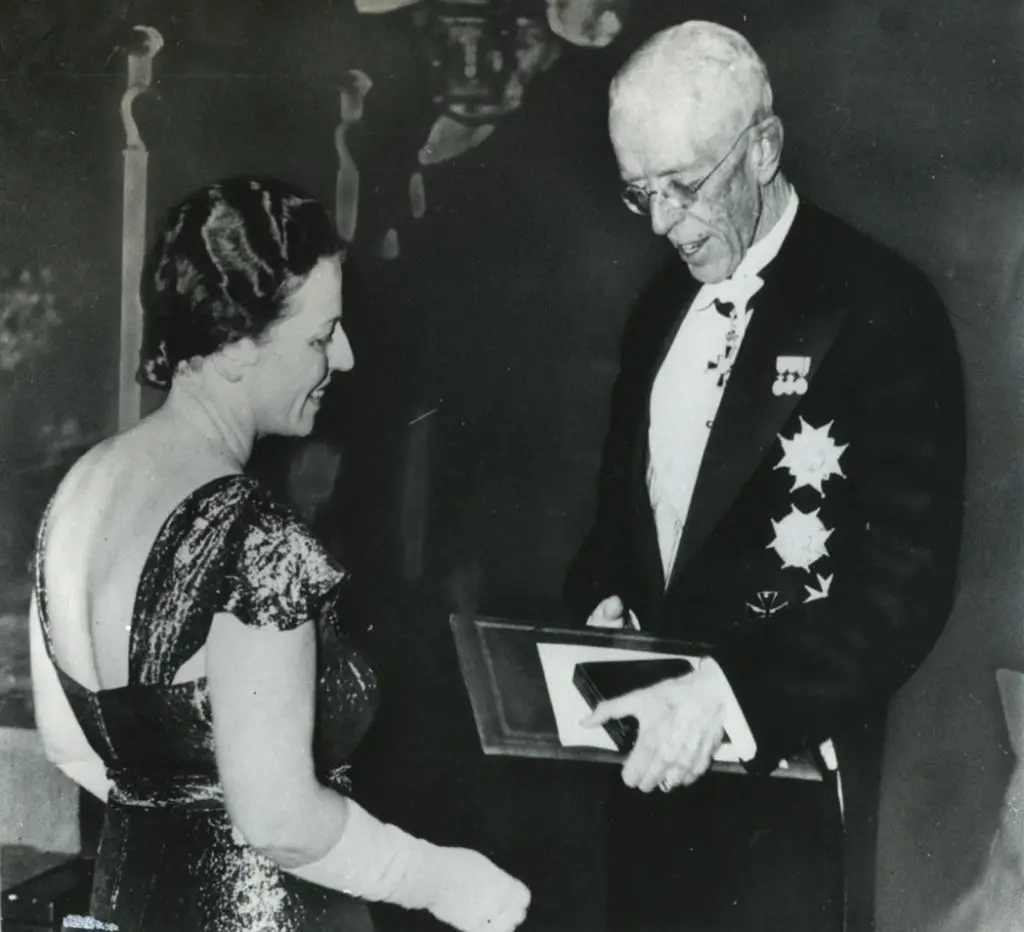“The test of a civilization is in the way that it cares for its helpless members.”
Pearl S. Buck
 December 10, 1938, Pearl S. Buck arrived at the Stockholm Concert Hall for the Nobel Prize Ceremony, but she was not there to merely attend the celebrated event. On that winters’ night, she was making history as the first American woman to be awarded a Pulitzer Prize and Nobel Prize, earning it “for her rich and truly epic descriptions of peasant life in China and for her biographical masterpieces.”
December 10, 1938, Pearl S. Buck arrived at the Stockholm Concert Hall for the Nobel Prize Ceremony, but she was not there to merely attend the celebrated event. On that winters’ night, she was making history as the first American woman to be awarded a Pulitzer Prize and Nobel Prize, earning it “for her rich and truly epic descriptions of peasant life in China and for her biographical masterpieces.”
The novels that ignited Pearl’s literary career and led to prestigious honors were The Good Earth (1931) and its two sequels, Sons (1932) and A House Divided (1935). The trilogy, inspired by her own life in China, offered millions of readers with their first glimpse into Chinese culture. But the consequential years of her life in spent in China, witnessing the struggles and triumphs of the Chinese people, did more than stimulate Pearl’s writing, they also inspired her remarkable life of service.
Pearl Comfort Sydenstricker was born to Caroline and Absalom Sydenstricker, Presbyterian missionaries then stationed in China, in Hillsboro, West Virginia on June 26, 1892. After their furlough at home in the United States ended, the Sydenstricker family returned to China and settled in Zhenjiang. There, they chose to live in the village amongst the Chinese people instead of the missionary compound, so Pearl and her siblings grew up immersed in the local culture. Her tutor, Mr. Kung, taught her Chinese history, writing, and Confucianism.

Caroline Sydenstricker homeschooled Pearl, teaching her the importance of being a competent writer. When she was only six years old, Pearl’s first literary piece was published in the children’s section of the English newspaper, Shanghai Mercury. Gaining an affinity for reading early on, Pearl was devouring books such as Oliver Twist and all of Charles Dickens’ works before the age of 10.
At the age of 18, Pearl returned to the United States to attend Randolph-Macon Woman’s College in Virginia. Four years later, she graduated with a degree in Philosophy and was honored to be asked to teach at her alma mater. Unfortunately, her stint as a professor did not last long. After just one semester, Pearl returned to China after learning that her mother was seriously ill.
Shortly after her return to China, Pearl met John Lossing Buck, a Cornell graduate serving as a missionary. They married in 1917 and spent the first few years of their marriage in the small town of Suzhou in Northern China, the region which would inspire Pearl when she wrote The Good Earth.
Her only natural child, Carol, was born on March 4, 1920. When Carol was a child, Pearl noticed that she was not developing as she should be, but John and the doctors paid little attention to the mother’s concern. Finally, Carol was diagnosed with PKU syndrome, leaving her with a permanent intellectual disability. At 9-years-old, Pearl enrolled Carol at the Vineland Training School in New Jersey, where she would remain until her death at the age of 72. Pearl’s book, The Child Who Never Grew (1950), was inspired by her real-life experience with Carol and dealing with PKU syndrome.
In the mid-1920s, John, Pearl, and young Carol sailed back to the United States, where Pearl enrolled at Cornell University and earned a master’s degree in English Literature. Before returning to China in the fall of 1925, the Bucks adopted a baby girl named Janice. Back in China, the rising tension between Nationalists and Communists made life tumultuous, especially for foreigners. During the 1927 Nanking Incident, the Buck family left their home in Nanking and escaped to Japan for a year.
After the family returned to China, Pearl and John made the decision to send Carol to Vineland Training School, but they found that they lacked the money to pay for the school. While still living in Nanking, Pearl invested more time and effort into becoming a professional writer, and she boldly pitched her first novel, East Wind, West Wind, to numerous publishers. After being met with several letters of rejection, Richard Walsh, an editor with the John Day Publishing Company, finally agreed to publish the novel. In 1930, Pearl S. Buck became a published author.
The next year, The Good Earth was released, topping the bestseller list for nearly two years and winning the Pulitzer Prize. In just one year, Pearl had gone from being an obscure writer residing in China to a literary sensation. The novel received more acclaim in 1937 when it was made into a feature-film starring Luise Rainer, who took home the Academy Award for her performance as the female lead, “O-Lan.”

As the situation in China deteriorated, so too did Pearl’s marriage to John Lossing Buck. In 1934, the family returned to the United States, and the next year, Pearl filed for divorce in Reno, Nevada. The day of the divorce, she married Richard Walsh, the editor responsible for launching her career. This marked the beginning of a creative and formidable partnership that lasted until Walsh’s death in 1960.
Pearl and Richard purchased Green Hills Farm in Bucks Country, Pennsylvania. The property consisted of around 500 lush acres, and the house, made of solid stone, dated back to 1835. Here, the couple raised their seven adopted children and several foster children. All the while, Pearl’s literary career remained proactive. She wrote on a variety of topics, including biographies of her mother and father, various novels inspired by her life in China, children’s books, and her autobiography. In total, Pearl published more than 100 pieces of literature. Her final manuscript, The Eternal Wonder, written just months before her death in 1973, was posthumously published in 2013.
As her name grew in recognition, Pearl began to invest more time in humanitarian work. She was staunch in her belief that all human beings deserved equality and was one of the first public figures to be a vocal supporter of civil rights in the United States. Observing the increase in the number of children fathered by American servicemen in Asia and ultimately left behind, Pearl established the Welcome House adoption program in 1949. This unique program was the first adoption agency to prioritize the placement of biracial children, and it successfully operated for more than 60 years.
Yearning to do more for children overseas, Pearl established the Pearl S. Buck Foundation in 1964, helping give children access to healthcare, education, and proper job training in their native countries. The Pearl S. Buck Foundation continues to thrive today as Pearl S. Buck International. The same year the Foundation was founded, Pearl traveled to South Korea to open the Opportunity Center and Orphanage, which later created offices in Vietnam, the Philippines, and Thailand.

During the course of her career, Pearl had only served as an advocate for the Chinese people. Through her literary works, she had served as their voice when the rest of the world was not listening, but Pearl never minced her words when it came to her opinions on the Communist Party. Her 1962 novel, Satan Never Sleeps, highlighted the tyranny practiced by Communist leaders, and for decades, the Chinese government remained hostile towards the author. It was not until the early 21st century that Pearl’s literary prowess was finally recognized and applauded in China.
Less than one year after making her final plea to enter China, Pearl S. Buck died of lung cancer on March 6, 1973. She was laid to rest at her tranquil home, Green Hills Farm, which is now a National Historic Site that is open to visitors. Pearl S. Buck’s literary works continue to be recognized and read across the globe, but it is her legacy as being a champion for the unseen and unheard that continues to inspire and transform lives.

Holley Snaith is a historian who specializes in 20th century U.S. history. She has worked with the FDR Library, the Richard Nixon Foundation, National Park Service, and the nonprofit Eleanor Roosevelt Center. In addition to writing about political history, Holley also researches entertainment and music history.
Feel free to reach out at holleysnaithwriter@gmail.com





